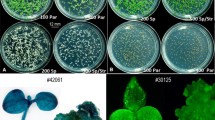Summary
Using tobacco as a model species, we have developed a simple procedure for the selection of spontaneous haploid plants under horticultural conditions, which does not require the use of any selective agent. One transgenic tobacco plant, homozygous for an antisense transgene able to silence the expression of nitrite reductase host genes, and encoding the second enzyme of the nitrate assimilation pathway, was used to pollinate two different cultivars of wild type tobacco plants. Seeds were sown at high density in the greenhouse and watered with a nutrient solution containing nitrate. Green plants able to develop normally emerged at a frequency of 5.10−4 in a mass of chlorotic retarded plants. Phenotypic and genetic analysis, chloroplast counting in stomatal guard cells and molecular hybridizations revealed that 22% of these plants were gynogenetic haploid plants exhibiting the maternal phenotype whereas the remaining 78% were true diploid plants that have lost the antisense transgene. These results demonstrate that a transgene able to silence the expression of a housekeeping gene can be utilized as a counter-selectionable marker for the rapid and easy selection of spontaneous haploid plants in transformable species.
Similar content being viewed by others
Abbreviations
- cDNA:
-
complementary DNA
- GUS:
-
glucuronidase
- ICR:
-
intra-chromosomal recombination
- KmR:
-
kanamycin resistant
- KmS:
-
kanamycin sensitive
- NAM:
-
naphtalene acetamide
- NiR:
-
nitrite reductase
- Nos:
-
nopaline synthase, Npt, neomycin phosphotransferase
- PCR:
-
polymerase chain reaction
- RiN:
-
antisense against nitrite reductase
- X-Gluc:
-
5bromo4chloro3indolyl glucuronide
References
Burck LG (1962) J. Hered. 53: 222–225
Butterfass T (1973) Protolasma 76: 167–195
Coïc Y, Lesaint C (1961). Hortic. fr. 8: 11–14
Gal S, Pisan B, Hohn T, Grimsley N, Hohn B (1991) EMBO J 10:1571–1578
Hamza S, Camilleri, C, Pollien J-M, Vaucheret H, Bourgin J-P, Chupeau Y (1993) Theor Appl Genet 86: 657–664
Horlow C, Defrance M-C, Pollien J-M, Goujaud J, Delon R, Pelletier G (1993) Euphytica 66: 45–53
Jefferson RA, Kavanagh TA, Bevan MW (1987) EMBO J 6: 3901–3907
Kronenberger J, Lépingle A, Caboche M, Vaucheret H (1993) Mol Gen Genet 236: 203–208
Muller JF, Goujaud J, Caboche M (1985) Mol. Gen. Genet. 199: 194–200
Pelletier G, Férault M, Goujaud J, Vedel F, Caboche M (1987) Theo. Appl. Genet. 75:13–15
Vaucheret H, Kronenberger J, Lépingle A, Vilaine F, Boutin JP, Caboche M (1992) Plant J. 2: 559–569
Author information
Authors and Affiliations
Additional information
Communicated by G. Pelletier
Rights and permissions
About this article
Cite this article
Vaucheret, H., Mourrain, P., Robalo, JC. et al. Nitrite reductase silencing as a tool for selecting spontaneous haploid plants. Plant Cell Reports 15, 12–16 (1995). https://doi.org/10.1007/BF01690244
Received:
Revised:
Issue Date:
DOI: https://doi.org/10.1007/BF01690244




